Compulsive Viewing: A Personal Pathology Part 2
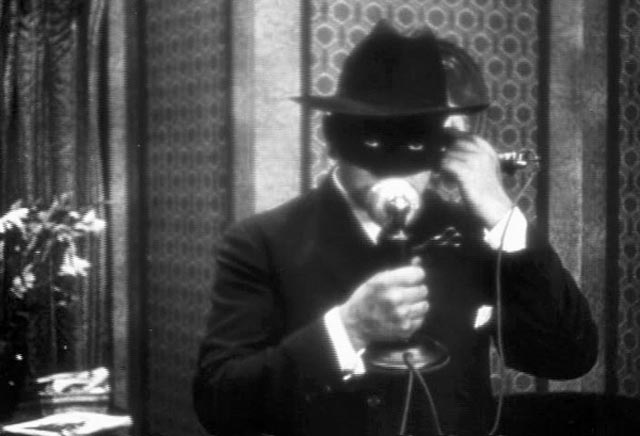
Continuing my survey of one month’s movie viewing:
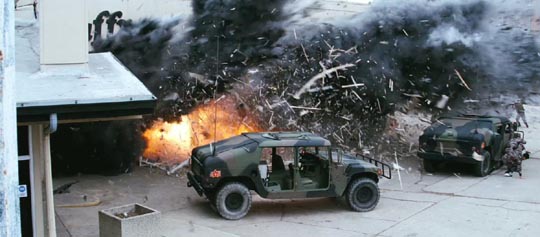
Red Dawn (Dan Bradley, 2012): As dumb as John Milius’ original about small town American kids fighting against vicious invaders. Milius had Nicaragua(!) taking over the States; here it’s North Korea backed by, for some reason, the Russians (aware of how much U.S. debt is held by China, I guess the producers were afraid of causing offence, although in the real world, China is the only ally North Korea has). Once again, the gung-ho highschool football team forms the backbone of the resistance, a feat they manage thanks to the complete incompetence of the professional army they’re up against; for some reason North Korean soldiers can’t hit a thing with their advanced weaponry. (DVD copy lent by a friend.)
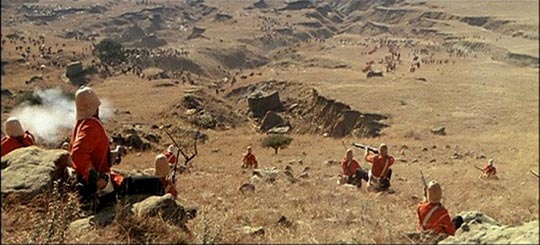
Zulu Dawn (Douglas Hickox, 1979): An all-star cast and a script co-written by Cy Endfield, director of the original Zulu (1964), tell the story of what happened immediately preceding the action of that earlier epic. A mixture of European arrogance and stupidity lead to an unnecessary war with the Zulu nation and the massacre of a British army. While the film is spectacular (cinematographer Ousama Rawi has a great eye for sweeping vistas and the mass movement of red-coated extras) and its point of view works as a corrective to Zulu‘s valorization of British courage, director Hickox and second unit director David Tomblin don’t always manage to maintain clarity in the action; the film’s geography (although shot on the actual locations where the war took place) is often too disjointed for the viewer to understand exactly what’s going on. This is partially explained by the documentary included on the Blu-ray, where it’s made clear that Hickox (director of the great Vincent Price black comedy Theatre of Blood [1973]) was out of his depth and the second unit more or less saved the production. (The Severin Blu-ray has some interesting extras, including a background featurette on the Zulu Wars with historian Ian Knight, an account of the troubled production by historical advisor Midge Carter, and a tour of the battlefield locations with Knight.)
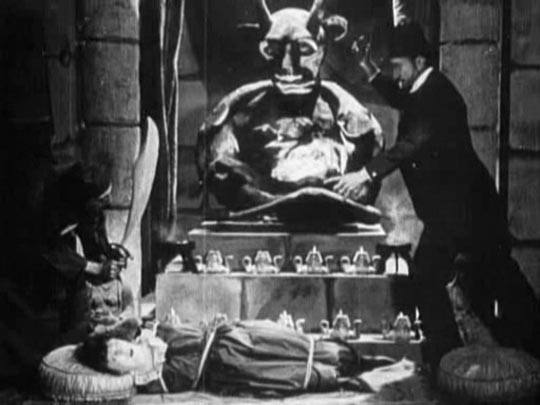
The Trail of the Octopus (Duke Worne, 1919): I ordered this 15-part silent serial directly from Serial Squadron after reading Ramsay Campbell’s interesting comments in the last issue of Video Watchdog, in which he compared it favourably to the work of Louis Feuillade. While it is indeed crazily inventive – with seemingly random hints of the supernatural and a remarkable sequence in which the villain’s scientific servant draws a planet down to smash into Montmartre in Paris, all in the service of a Yellow Peril plot to rule the world – the storytelling is rather sluggish and the supposedly brilliant criminologist hero has an irritating tendency to stand around waiting to be cracked over the head so the heroine can be kidnapped yet again (she’s grabbed in almost every episode). Yes, it has a refreshing disdain for narrative coherence, but it lacks Feuillade’s remarkable combination of reality and oneiric fantasy, though there are striking moments of visual invention – particularly a gunfight inside a room which is lit only by the muzzle flashes of the weapons. (Despite what Campbell says in his Video Watchdog essay and what it actually says on the DVD case, this edition from Serial Squadron, an outfit which seems passionately committed to restoring and preserving the genre, is not a three-disk set; disappointingly, the fourteen existing episodes and one “reconstructed” episode are crammed onto two single-layer DVD-rs, which of course makes for a pretty low bit-rate; a pity since the overall print quality seems surprisingly good. The synth-heavy score by Kevin McLeod at times seems too “modern”, and tends to get a bit repetitive, though it generally supports the action quite well.) (NOTE August 2017: this serial no longer appears to be available, though Serial Squadron still list a lot of other titles on their website.)
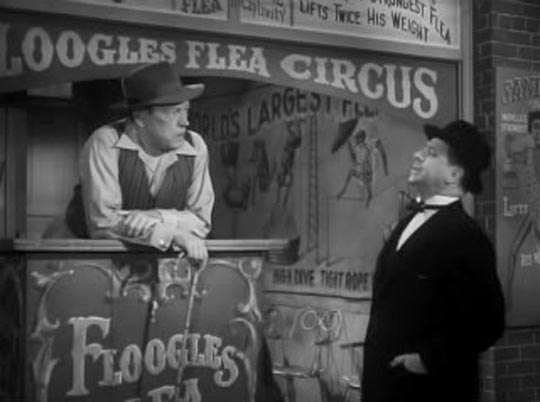
It’s In the Bag! (Richard Wallace, 1945): Although not as inventive as Hellzapoppin, this showcase for radio star Fred Allen and numerous other familiar (and not so familiar) radio personalities, gleefully trashes the rules of Hollywood storytelling, beginning with Allen’s contemptuous running commentary over the opening credits and continuing through numerous non-sequitur digressions hung on a slim framework based on the Russian story of the twelve chairs (here reduced to five). Allen plays the owner of a flea circus who learns that he’s the sole heir of a recently deceased wealthy uncle; he and his family have already started spending the money when they learn the old guy was not simply bankrupt – he was also murdered, with the police suspecting Allen. Running ahead of the police and his uncle’s crooked business partners, Allen has to track down the five chairs which constitute his entire inheritance because, immediately after selling them, he learns that hidden in one is $300,000. More amusing than outright funny, the film (surprisingly co-written by Alma Reville, Hitchcock’s wife) illustrates a particular style of comedy which wasn’t very common in the movies but lasted several decades on radio. (Another extras-free Blu-Ray from Olive Films.)
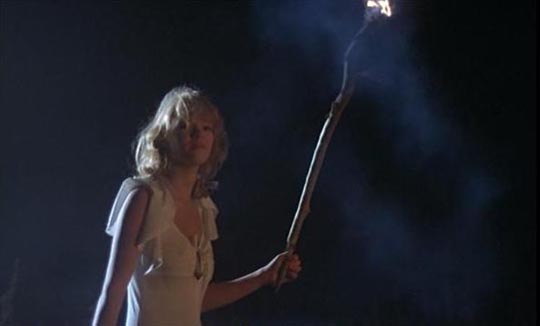
Les Raisins de la Morte (Jean Rollin, 1978): Taken by Rollin as a job-for-hire, his first “gore” film is one of the more original Euro-zombie movies, and would make a fine companion piece for Jorge Grau’s Living Dead at Manchester Morgue (aka Let Sleeping Corpses Lie, 1974). Experimental pesticides used on the grape crop in a wine-making area of France turn the population into a homicidal horde. Less zombies than psychotics a la George Romero’s The Crazies (1973, also caused by chemical poisoning), the twist in Rollin’s film is that the killers are conscious of what they’re compelled to do – there’s a harrowing moment as one farmer screams in despair as he kills his wife. As with so many of Rollin’s films, he found some wonderfully atmospheric locations in which to stage the action and the statuesque Brigitte Lahaie adds her distinctive presence to the proceedings. (The Redemption Blu-ray includes the usual brief introduction by Rollin in heavily-accented English, but the real bonus is a 50-minute interview with the director from 2007; although roughly shot on a small handheld camera, it gives an illuminating impression of Rollin, focusing on his literary interests and influences.)
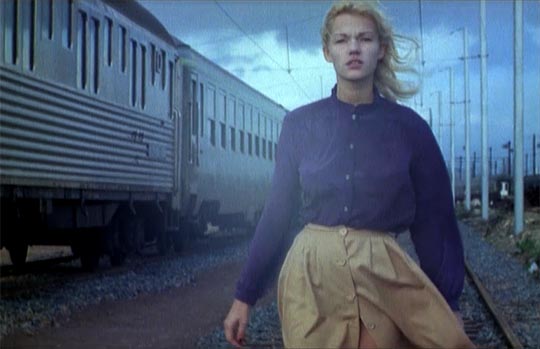
La Nuit des Traquees (Jean Rollin, 1980): When producer Andre Samarcq proposed that Rollin shoot yet another hardcore feature for him, Rollin countered with an offer to shoot a “real movie” for the same amount of money, quickly writing this script and filming it over nine days. Although compromised by budget and schedule limitations, this is one of Rollin’s most interesting films, reminiscent of early Cronenberg (especially the experimental features Stereo and Crimes of the Future) with its depiction of a group of people suffering from a mysterious sickness which is gradually destroying their capacity to remember, and eventually to think and function in any way. The central role of Elisabeth provides Brigitte Lahaie with her most substantial part of the many she played for Rollin, and her performance as a woman conscious that she is gradually losing not simply her memory, but her entire identity is subtle and moving. Given Rollin’s repeated use of memory as a key theme in many of his films, there’s something particularly disturbing about its obliteration here and the film’s climactic echoes of the Holocaust and its final tentative, fragile intimation of the survival of human feeling even when the mind and personality are lost, provides one of the most affecting moments in all his work. (Extras include a brief introduction and two very short interview clips with Rollin, plus a couple of short softcore sex scenes he shot to boost the film’s commercial appeal; when the movie proved a financial failure, the producer shot and inserted some hardcore scenes against Rollin’s wishes, pushing the ambitious project back into the porn ghetto the director had been trying to escape.)
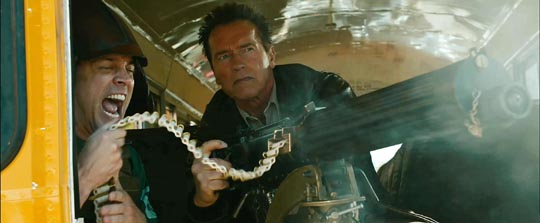
The Last Stand (Kim Jee-woon, 2013): Arnold Schwatzenegger’s post-gubernatorial comeback had some potential to be more than a routine action movie as it marks the American debut of the Korean director of The Quiet Family (1998) and A Tale of Two Sisters (2003), but it somehow never really takes off. Arnold is the aging sheriff of a small border town which unfortunately is in the direct line of escape of a lethal Mexican drug lord who has just broken out of FBI custody. Arnold and his ragged group of deputies are determined not to let the guy through and essentially booby trap the whole town and turn it into a battle zone … it all climaxes straddling the border for a one-on-one fistfight between the sheriff and the bad guy (Eduardo Noriega). (DVD lent by a friend.)
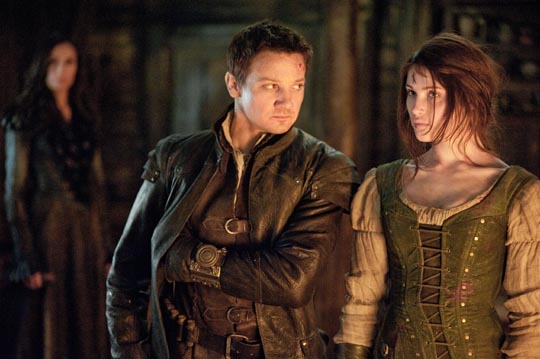
Hansel & Gretel: Witch Hunters (Tommy Wirkola, 2013): Almost universally derided, this black comedy rewrite of the famous fairy tale is actually fairly entertaining and certainly nicely designed in a grubbily detailed way. The two kids, traumatized by their experiences, grow up to become professional witch hunters, coming to town just as a powerful group of witches have been kidnapping children in preparation for a once-in-a-lifetime ceremony which will render them all impervious to fire. These are not sensitive wiccans but monstrous consorters with demons (though the brother and sister do eventually learn that there are also good white witches). Norwegian director Tommy Wirkola, who previously made the passable Nazi zombie horror-comedy Dead Snow (2009), keeps things moving briskly and almost achieves an Evil Dead-like balance between gross horror and laughs. (Yet another borrowed DVD.)

London Tales (John Krish & David Eady, 1958, 1966, 1976): The first volume in the BFI’s series of releases from the Children’s Film Foundation offers three short features which span much of the CFF’s lifespan (it was founded in 1950 under the aegis of J. Arthur Rank, and finally closed shop in the early ’80s). It was a successful long-running effort to create suitable homegrown product for kids’ matinees, to replace Hollywood serials and westerns with wholesome kid-oriented stories which reflected the lives of their audience. This first volume contains John Krish’s The Salvage Gang (1958), about a group of kids trying to raise money to replace something they broke before one of their fathers finds out, offering a fascinating tour of London still rebuilding after the war (shot in gorgeous black-and-white); and two films directed by David Eady – Operation Third Form (1966), in which a bunch of school kids foil the theft of a valuable painting, and Night Ferry (1976), in which several kids uncover a plot to smuggle a stolen Egyptian mummy out of the country. All the films deal with children solving problems for themselves (adults usually only enter the picture at the climax to wrap things up), conveying a message of self-sufficiency and self-confidence. Although the CFF’s aims were definitely built on the idea of “moral entertainment”, thanks to skilled filmmakers working inventively on very low budgets, any potential tendency towards preachiness is subsumed under exciting, frequently funny kid-oriented adventures. (The BFI Region-free DVD includes an interesting 14-minute US TV spot about the CFF, including interviews with J. Arthur Rank and the foundation’s director Mary Field, along with some on-set clips from The Salvage Gang and a brief interview with John Krish.)
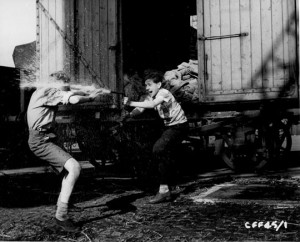
The Race Is On (various, 1957, 1967, 1978): This second volume of CFF short features, like the first, spans three decades. Soapbox Derby, directed by Darcy Conyers, sees two gangs competing in a race with home-made vehicles; team loyalties are tested and one group cheats outrageously with the help of an unscrupulous father, and there are some surprisingly violent fistfights. The other two films shift quite radically into outright fantasy. The Sky-Bike, written and directed by Charles Frend, a prolific Ealing director before spending most of the ’60s and ’70s working in television, is about a boy who dreams of being a pilot, who hooks up with an old man who’s building a pedal-powered plane for a competition; a rival crew sabotage their efforts and even resort to kidnapping, before the boy finally gets to take off and fly. Jeremy Summers’ Sammy’s Super T-Shirt is a variation on The Man In the White Suit, with a scientist’s attempts to create indestructible fabric giving Sammy’s lucky shirt the power to make him faster and stronger than anyone else in the neighbourhood; once again, adults are the villains, with the scientist and his boss resorting to kidnapping before Sammy manages to make it to the local track meet and … well, the ending comes as no surprise. (The Region-free BFI DVD contains no extras.)
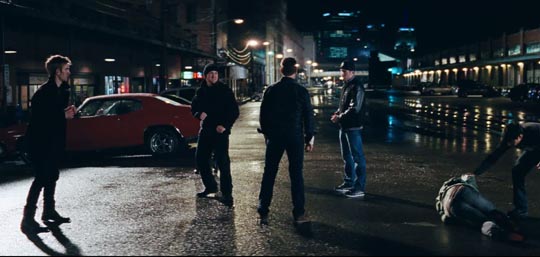
Jack Reacher (Christopher McQuarrie, 2012): I have a friend who’s a fan of Lee Child’s Jack Reacher thrillers and he was deeply offended when it was announced that Tom Cruise would star in the first movie based on the stories – because in the books, Reacher is a big, powerful man quite unlike the small, compact Cruise. Not having read any of the books, I can’t judge how inappropriate the casting is, but I can say that Christopher McQuarrie has made a very satisfying old-fashioned thriller in which former military policeman Reacher, who has gone underground after giving up on the system in disgust, resurfaces after an apparent random shooting incident in Pittsburg involving a former army sniper he dealt with in Iraq. Reacher’s investigation uncovers a very non-random conspiracy involving Russian gangsters and corrupt cops and politicians leading to a big action finale in a quarry at night. While the movie might be embraced by Second Amendment fanatics for all the fetishized gun use, it works very well as a potential franchise launch. (Another DVD lent by a friend.)
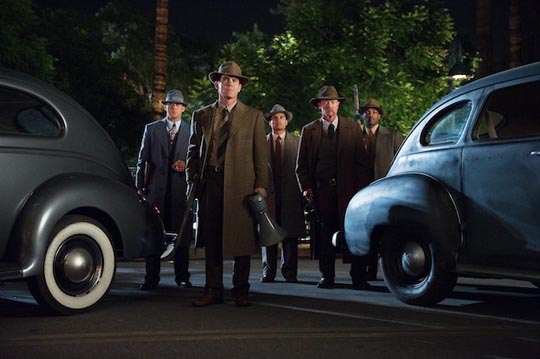
Gangster Squad (Ruben Fleischer, 2013): This is the movie that was quickly revised after the Aurora, Colorado, theatre shooting last summer. I’m not sure how the original ending was meant to play, but the one it has now is pretty silly. Allegedly based on real events, it tells the story of a handful of cops who put away their badges to fight a war against Mickey Cohen as the gangster tries to consolidate his hold over Los Angeles in the ’40s. There’s a lot of tough talk about doing what’s right even if it isn’t strictly legal, and a lot of scenery-chewing ranting from Sean Penn as Cohen, who sees his criminal ambitions as the very definition of the American Dream. There are gun fights, explosions, tender moments with fearful but understanding wives (one of them pregnant, of course), and that big ending with an assault on a heavily fortified hotel, a pitched machine gun battle in the streets of L.A. which – as in The Last Stand – ends up in a one-on-one grueling fist fight in which righteous anger overcomes venal evil. (And another loaner.)
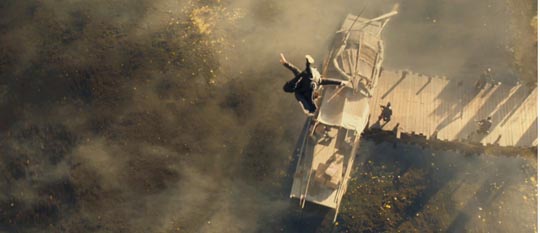
Flying Swords of Dragon Gate (Tsui Hark, 2011): This latest iteration of the oft-told story of Dragon Gate Inn – a remote outpost where spies, outlaws, and feuding government agencies come together for some spectacular sword fights – represents the transformation of a venerable genre by the availability of modern technologies. The pleasures of the classic Chinese martial arts movie, as stylized as the musical, lie in their narratives of decency and honour confronting corruption and, more particularly, in their phenomenal displays of stunt work in the fight sequences. The use of acrobatic athleticism in combination with elaborate wire work is exhilarating to watch and given resonance by the underlying moral conflicts. In recent years, however, the availability of computer imaging has led directors like Tsui Hark to bloat the scale of their movies – there are vast CG landscapes and cities in Flying Swords which look just like, well, CG – and “enhance” the action. But all the flying about of CG characters actually diminishes the impact of the fight scenes; the whole thing becomes cartoonish and weightless, so while theoretically the FX techniques are adding to the excitement, they actually result in a lower level of audience engagement. Although superficially more spectacular, this new movie is a lot less entertaining than Raymond Lee’s Dragon Inn (1992) or King Hu’s Dragon Gate Inn (1967). (The Vivendi Entertainment Blu-ray contains both 2D and 3D versions, along with several featurettes on the making of the film.)
Finally, there’s Criterion’s Blu-ray of Chronicle of a Summer (1961) by Jean Rouch & Edgar Morin, but that one requires more space and greater consideration, so I’ll leave it for another day.
*
I’m not sure what, if anything, is to be learned from all this. My viewing over the month of May has spanned almost a hundred years (from 1919 to 2013), covers numerous genres and nationalities, mainstream and “alternative”, drama and documentary and docu-drama, and out of the two-and-a-half dozen titles here I’d have to say that only a handful were actually a waste of my time. The rest range from flawed but interesting, to pretty good undemanding entertainment, to historically interesting – and a few are actually great movies. Still, maybe I should get out more!
Comments